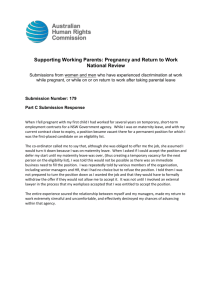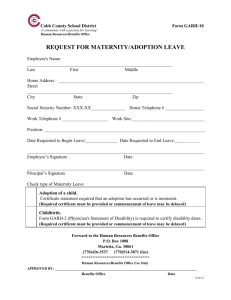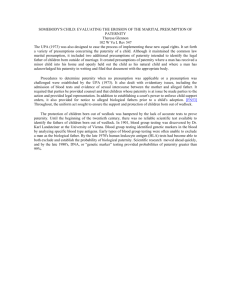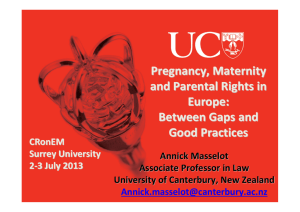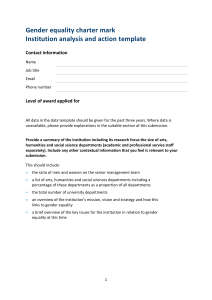Maternity Paternity and Adoption
advertisement
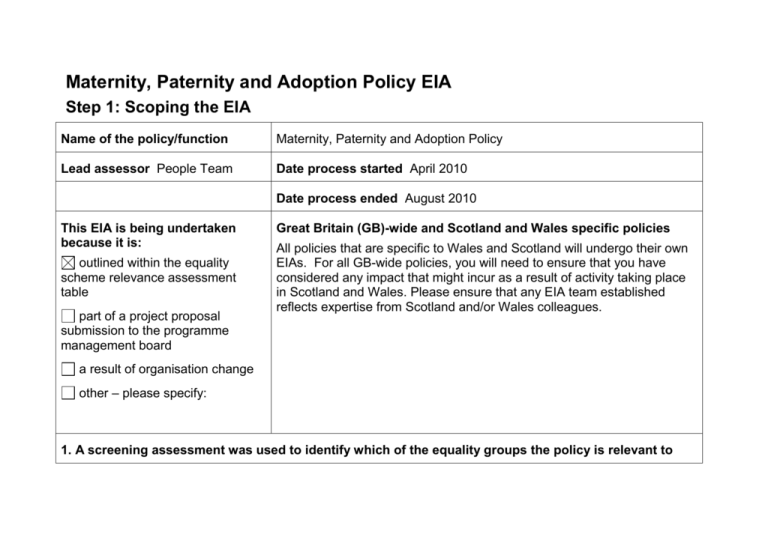
Maternity, Paternity and Adoption Policy EIA Step 1: Scoping the EIA Name of the policy/function Maternity, Paternity and Adoption Policy Lead assessor People Team Date process started April 2010 Date process ended August 2010 This EIA is being undertaken because it is: outlined within the equality scheme relevance assessment table part of a project proposal submission to the programme management board Great Britain (GB)-wide and Scotland and Wales specific policies All policies that are specific to Wales and Scotland will undergo their own EIAs. For all GB-wide policies, you will need to ensure that you have considered any impact that might incur as a result of activity taking place in Scotland and Wales. Please ensure that any EIA team established reflects expertise from Scotland and/or Wales colleagues. a result of organisation change other – please specify: 1. A screening assessment was used to identify which of the equality groups the policy is relevant to A screening was carried out (Please tick if applicable) If a screening was carried out please complete the following: A screening has identified the policy as having relevance to the following equality groups (please tick below): Age Disability Race Gender Sexual orientation Religion or belief Transgender Date of screening: Date screening signed off and approved by internal equalities team: A screening has not been completed Please tick if applicable If a screening has not been completed and your policy area is not obviously focused on one or more particular equality group (such as race and the construction industry, your assessment must consider all of the equality strands. N.B Assessors of single strand projects must also consider multi- discrimination dimensions. See guidance for further details on assessing impact and multi-discrimination 2. What are the main aims, purpose and outcomes of the policy? You should be clear about the policy proposal: what do you hope to achieve by it? Who will benefit from it? Aims: The aim of the policy is for the Commission to provide enhanced pay and leave for adoption, maternity and paternity. The Commission recognises that employees want to strike a balance between their home and work life and is committed to offering flexible employment practices where possible to support this. Purpose and Outcome: The purpose of this policy is to provide guidance on the rights of employees who wish to take maternity, paternity or adoption leave, as well as to set out their obligations and the Commission’s policies and procedures. The policy sets out the approach the Commission will follow to ensure consistency and fairness in treatment for all employees who make a request. As the Commission is committed to equality of opportunity for all employees, this policy will help ensure that we do not treat any employee less favourably because they are expecting or adopting a child or for any reason connected with maternity, paternity or adoption. Who will benefit: This policy applies to all Commission employees who meet the appropriate qualifying criteria. In some ways employee’s rights and entitlements are the same whether they are on maternity, adoption or paternity leave and where this is the case, these issues are considered together. Maternity leave is available to mothers only and is generally intended to protect the health of the mother and newborn child in the period around childbirth. Paternity leave is available typically to fathers or partners around the time of the birth or adoption of a child and is intended to enable the father or partner to spend time with their partner and new child. Adoption leave is available to adopters and is intended to enable the adopter to spend time with the child around the time of placement with them for adoption. 3. Which aspects/activities of the policy are particularly relevant to equality? Training Communication Health and Safety Accessibility Monitoring 4. Gathering the evidence List below available data and research that will be used to determine impact on the different equality groups Your assessment must include equality monitoring data gathered by your directorate. If data is not referenced and a link provided to the source, your EIA will not be signed off by the internal equalities team. If you don’t have any equality monitoring data please set out in question 5 below the mechanisms you will put in place to collect this data. It is your responsibility to identify the available data and use it within your assessment. The Commission does not currently collate equality monitoring data available in relation to this policy but this is now being developed in order that monitoring data can be produced in March 2011 to review the impact of the policy. Research conducted by the EHRC: Working Better research Research conducted by the EOC: Supporting Parents and Carers Pregnancy Discrimination at Work: A qualitative study Pregnant and Productive research 5. Evidence gaps Do you require further information to gauge the probability and/or extent of impact? No: please go on to question 6. Yes: please explain how you will fill any evidence gaps. Please be specific. We don’t just want to know what data is missing; we want to know how you will go about collating it, time frames and responsibilities. From August 2010 onwards the following data will be recorded and monitored: Number of staff who take maternity, paternity, adoption, surrogacy adoption or additional paternity leave The length of leave taken Number of staff returning from maternity, paternity, adoption, surrogacy adoption or additional paternity leave The above information analysed by equality strand. We do not currently collate and analyse this data by equality strand, we are planning to be in a position to begin monitoring by strand in 2010. This will be led by the People Directorate. 6. Involvement and consultation. You are required to involve and consult stakeholders during your assessment. The extent of the consultation will depend on the nature of the policy. All major work programmes and strategies should make arrangements to consult throughout assessment. That includes gathering views on the initial aims of the policy and also on any impact. This should allow an informed view to be given on the options identified, as well as the assessment of impacts. Stakeholders’ views on the most effective methods of addressing unwanted impacts should be considered. Following consultation and involvement it may be necessary to go back to the assessment and revise your findings. Please indicate: the consultation that has taken place, who with, when and how summary of the feedback link to any written record of the consultation so that it can be published alongside this assessment (if this is not provided your assessment cannot be signed off by the internal equalities team), and how you will continue to gain stakeholder views once your policy has been implemented. Consultation has taken place with the following stakeholders: HR Business partners Union representatives Internal equalities Commission employees Feedback is being sought from employees currently away on, or recently returned from, maternity, paternity or adoption leave. Key messages from consultation: Query: There was a query regarding the requirement to repay maternity pay if the individual did not return to work for 3 months following the end of maternity leave. The issue was raised that this could potentially lead to indirect discrimination, for example where an individual does not feel able to return due to postnatal depression. One member suggested that an example be provided of situations where repayment might not be required. Action taken: It was agreed that the People Director should decide in cases where non-repayment of maternity pay is being considered. One member queried the requirement to repay if the individual has not returned to work for 3 months and suggested that this could be 1 month instead. it was confirmed that the Commission considered 3 months to be a reasonable timescale and that this would remain in the policy. Query: It was raised that as a Commission we may need to go further than the legal requirements in relation to Health and Safety e.g. in carrying out a stress risk assessment Action taken: The policy has been extended to state that all pregnant women will have a risk assessment (and not just those in certain roles). HR policy consultation, March 2010 Following points raised: Query: Maybe a separate Maternity/ Pregnancy policy should be developed and that this should cover workers, not just employees. Action taken: A separate Maternity/ Pregnancy policy will be considered at the review stage of this policy and will reflect maternity and pregnancy as a protected group within the new public sector equality duty. Query: Rename paternity leave 'birth' leave Action taken: Paternity Leave is referred to in the policy as Paternity / Maternity Support Leave. Paternity leave is the title of this leave in legislation so it is important to still refer to this term to ensure staff are aware of the entitlements. Further consultation taken place with EHRC staff, March 2010 Query: Staff felt that a clear definition of what is meant by the term 'partner' was important, and whether proof of having a partner was required. Action taken: Partner is defined under the Paternity section of the policy. Proof of being a partner is not required, it is proof of the expected week of childbirth or expected week of matching that is required in all cases. Query: There was a query around the requirement for women returning from maternity leave, and submitting a flexible working request, to give 14 weeks notice. Action Taken: The reason for this time frame is to allow time for the request to be considered, a meeting arranged, outcome decided and then additional resource to be recruited where this is required as a result of the flexible working request. The policy has been amended slightly to say that requests received after this time limit will still be considered, but that this may result in a delay to them being implemented. Query: What rights do employees have to paternity leave for partners whose child is stillborn. Action Taken: If a child is still born (after 24 weeks of pregnancy), an employee will be still be entitled to paternity leave as set out in the policy. This has now been clarified in Section 14 of the policy. Query: Are partners able to attend antenatal appointments Action taken: Time off can be agreed with line managers to individuals who meet the requirements for paternity leave. This is now in section 11.1 of the policy. Query: Staff questioned the requirement to give notice for changing dates of maternity/ paternity/ adoption leave. Action taken: The timeframes set out are those outlined in legislation. The reason for requiring this notice is to ensure that the necessary arrangements for cover can be made. Query: Staff felt the reference to 'women of childbearing age' should be altered. Action taken: This refers to Health and Safety terminology and its use is required. Query: More information around the rights for surrogates and the mother of the child in surrogacy situations would be helpful. Action taken: Guidance on surrogacy will be developed and incorporated into the policy when it is reviewed 3 months after publication Query: Clarity was requested over whether all pregnant staff receive a risk assessment Action taken: Pregnant staff receive a risk assessment. This is outlined in 9.1 Definition of 'not less favourable treatment' should be included in the glossary. Action taken: This will be included in a ‘Glossary of terms’ for the policies Query: More clarity was requested over what would happen if a pregnant member of staff gave less than the required notice. Action taken: If less than the required notice is given this may mean that arrangements can’t be made and could result in delays e.g. to benefits being processed. Individuals would be consulted with in these cases to try and minimise any impact. Continued engagement 1. A feedback prompt has been included in the equality impact assessment statement on all policies. We hope this will encourage staff to provide ongoing feedback that we can use to inform subsequent reviews of this policy. Step 2: Assessing impact and opportunities to promote equality 7. What kind of equality impact can you see being evidenced in respect of the individual equality duties? Please provide as much detail as possible as to how you have reached the conclusions that you make and document them clearly below. Effective implementation of this policy requires individuals to understand their rights and responsibilities relating to this policy, including the additional enhancements delivered by this policy. Failure to carry out risk assessments on pregnant staff could adversely affect female staff. Poor communication of this policy could impact negatively on some staff groups. For example if the policy is not available in alternative formats, staff with disabilities could be impacted in a negative way. 8. What can you do further to maximise opportunities to further promote equality and ensure equitable outcomes for different communities and groups? Step 3: Strengthening your policy 9. What will you do to remove any negative impact identified and further promote equality? Please document the actions required to strengthen your policy in the table below. As a result of this assessment, to ensure that the policy is correctly implemented and that it achieves a positive impact, the Commission has: Revised the policy as it has been developed, considering and acting on the feedback it has received (See above) Revised terminology so that it is of a more supportive nature The Commission will take action regarding the following: Training Undertake training for all managers through the implementation of the learning and development strategy for 2010-2012. Have an intranet based advice / good practice guide for managers. Accessibility A glossary will be created to support staff to understand and clarify the meaning of terms used within policy documents. Wherever possible reasonable adjustments will be put in place to support full participation in the policies procedures and practices. Staff will be expected to adhere to our reasonable adjustments guidelines and where there is uncertainty, the national accessibility officer should be consulted. Communication A communication plan will be implemented, ensuring Managers feel confident and have the knowledge to use the guidelines and policies, and staff are clear about what the policies mean for them personally. Staff involved in the communication process will be required to give regard to our reasonable adjustments policy, including: Alternative formats of policies will be sent to those that need it Email – appropriate font size and accessible documents will be used to ensure no one is excluded Monitoring Regularly monitor both the implementation and outcomes of the Maternity, Paternity and Adoption policy. This analysis will be reported to the Senior Management Team. This policy will be reviewed in twelve months time when it will be clearer what the actual impact of this policy has been, and how actions implemented as a result of this assessment have supported the successful implementation of this policy. Action planning Action(s) Timescales Responsible lead Outcome expected August 2010 Internal Comms People Directorate People team Facilities team Health & Safety Committee Improved consultative and involvement of staff Identify any necessary amendments to the policy to ensure the health and safety of pregnant employees No training on this policy. Implement communication plan Consultation with Health and March 2011 Safety representatives in relation to risk assessments carried out Step 4: Monitoring and review 10. What monitoring mechanisms do you have in place to assess the actual impact of your policy? The Commission has just undertaken a data validation exercise and this will be used to underpin further data collection that will take place to assess the impact of People policies introduced over the next twelve months. The following have been identified as the data sets that will provide insight into how well this policy is working: Number of staff who take maternity, paternity, adoption, surrogacy adoption or additional paternity leave The length of leave taken Number of staff returning from maternity, paternity, adoption, surrogacy adoption or additional paternity leave The above information analysed by equality strand. This data will be collated and used at the next review which is planned for December 2010. If for any reason there are concerns regarding the implementation of this policy the review date can be brought forward. Collation and analysis will be the responsibility of the People directorate Please provide a review date to complete an update Date of next review on this assessment. August 2011


